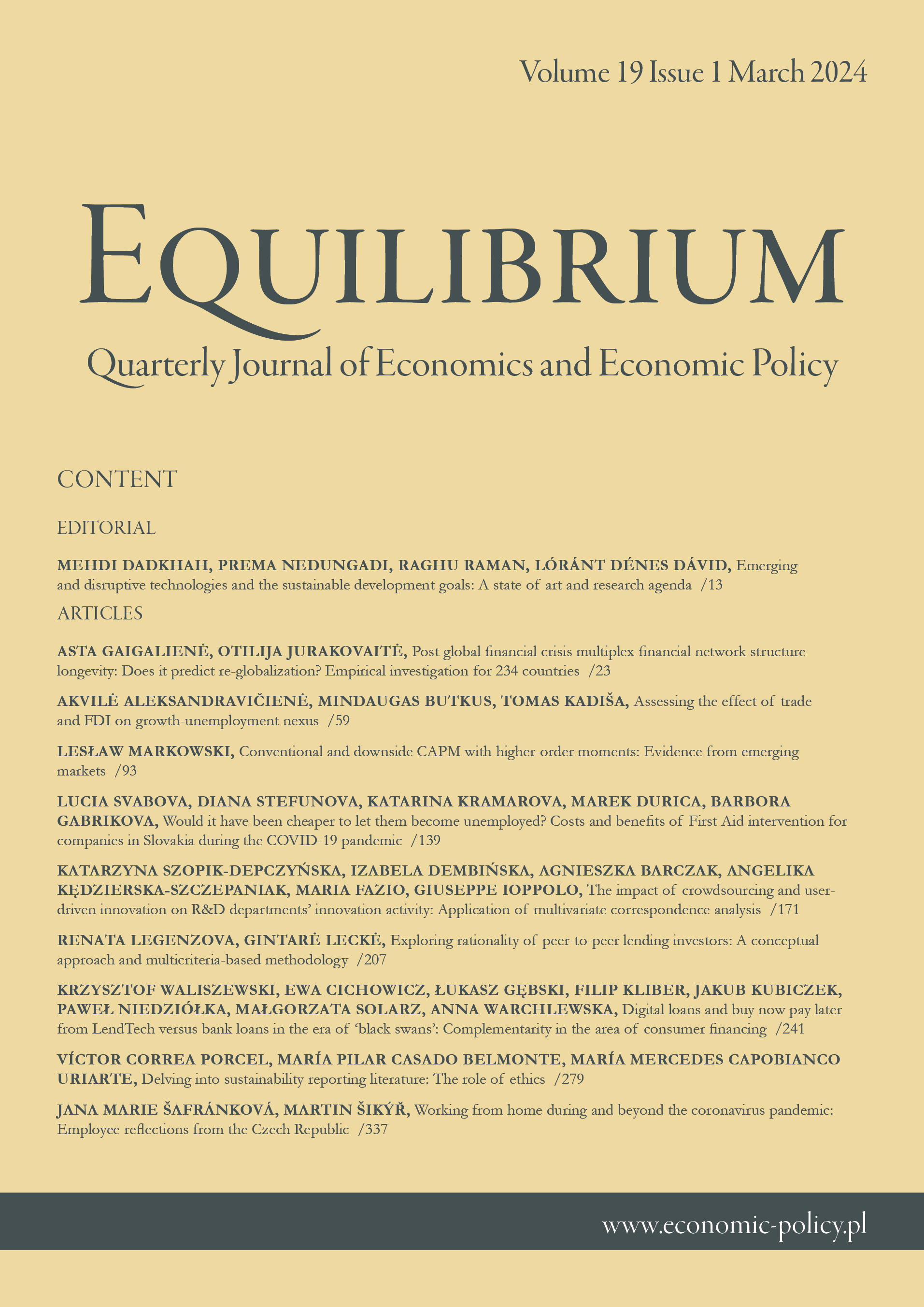2007-2013年欧盟结构基金在欧盟成员国的主要成果:运输部门效率分析
IF 6.2
Q1 ECONOMICS
Equilibrium-Quarterly Journal of Economics and Economic Policy
Pub Date : 2018-06-30
DOI:10.24136/EQ.2018.015
引用次数: 16
摘要
研究背景:欧盟目前通过2014-2010年欧洲结构和投资基金以及之前的欧盟结构基金的各种金融工具向成员国提供财政支持。在这两个术语中,这些基金代表了欧盟凝聚力政策的主要工具,以维持领土发展、提高竞争力和消除地区差异。欧盟基金的总体影响取决于该国的资金结构和吸收能力。文章目的:整个欧盟成员国的资金效率是整个欧盟发展的一个根本问题。作者认为,阻止挖掘欧盟基金的效率是一个非常重要的问题,因此本文对欧盟凝聚力政策在成员国的作用的辩论做出了贡献。本文通过效率分析,重点研究了2007-2013年规划期间欧盟相关基金在基础设施方面的领土效应。方法:效率分析以国家一级的数据为基础,这些数据来源于对2007-2013年凝聚力政策方案的事后评估,代表了投入和产出变量,以分析所提供的资金是否实现了促进目标国家增长的目标,以及更多的资源是否在交通可达性方面产生了更强的增长效应。本文以面向产出的BCC-VRS效率模型和面向产出的APM-VRS超效率后续模型的形式,对数据包络分析的跨国比较分析、数据集描述性分析和多准则方法进行了研究。调查结果和附加值:本文旨在检验两项投入和五项产出的因素,试图阐明成员国在运输部门有效利用欧洲区域发展基金和凝聚力基金方面所取得的差异。该文件确定了这些国家是否更有效地提高了与运输相关的竞争优势水平。初步结果显示,大多数资金数额较低的国家实现了更高的效率,尤其是所谓“旧欧盟成员国”(即欧盟15国集团)中的国家。本文章由计算机程序翻译,如有差异,请以英文原文为准。
The main achievements of the EU structural funds 2007-2013 in the EU member states: efficiency analysis of transport sector
Research background: The European Union currently provides financial support to the Member States through various financial tools from European Structural and Investment Funds 2014–2020, and previously from the EU Structural Funds. In both terminologies, the funds represent the main instrument of EU Cohesion Policy to sustain territorial development, to increase competitiveness and to eliminate regional disparities. The overall impact of EU Funds depends on the structure of funding and absorption capacity of the country.
Purpose of the article: The efficiency of funding across the EU Member States is a fundamental issue for EU development as a whole. The Author considers deter-mining the efficiency of EU Funds as an issue of high importance, and therefore this paper provides a contribution to the debate on the role of EU Cohesion Policy in the Member States. The paper focuses on territorial effects of relevant EU Funds in programming period 2007–2013 in infrastructure through efficiency analysis.
Methods: Efficiency analysis is based on data at the country level, originating from ex-post evaluation of Cohesion Policy programmes 2007–2013 and representing the input and output variables to analyse whether the goal of fostering growth in the target countries have been achieved with the funds provided, and whether or not more resources generated stronger growth effects in transport accessibility. The paper deals with comparative cross-country analysis, descriptive analysis of dataset and multiple-criteria approach of Data Envelopment Analysis (DEA) in the form of output-oriented BCC VRS model of efficiency and output-oriented APM VRS subsequently model of super-efficiency.
Findings & Value added: The paper aims to test the factors of two inputs and five outputs, trying to elucidate the differences obtained by the Member States in effective use of the European Regional Development Fund and the Cohesion Fund in the transport sector. The paper determines if the countries have been more efficient in increasing their levels of competitive advantages linked with transport. Preliminary results reveal that most countries with a lower amount of funding achieve higher efficiency, especially countries in a group of so-called “old EU Member States”, i.e. group EU15.
求助全文
通过发布文献求助,成功后即可免费获取论文全文。
去求助
来源期刊
CiteScore
9.20
自引率
3.50%
发文量
28
审稿时长
36 weeks
期刊介绍:
Equilibrium. Quarterly Journal of Economics and Economic Policy is a scientific journal dedicated to economics, which is the result of close cooperation between the Instytut Badań Gospodarczych/Institute of Economic Research (Poland) and Polish Economic Society and leading European universities. The journal constitutes a platform for exchange of views of the scientific community, as well as reflects the current status and trends of world science and economy.
The journal especially welcome empirical articles making use of quantitative methods in: Macroeconomics and Monetary Economics, International Economics, Financial Economics and Banking, Public Economics, Business Economics, Labor and Demographic Economics, Economic Development, and Technological Change, and Growth.
Current most preferable topics and special issues:
The economics of artificial intelligence: business potentials and risks;
Digitalization and entrepreneurship in economics;
Sustainable socio-economic development, environmental and ecological economics;
Transition in the energy market (improving energy efficiency, alternative energy sources, renewable energy, energy security).

 求助内容:
求助内容: 应助结果提醒方式:
应助结果提醒方式:


